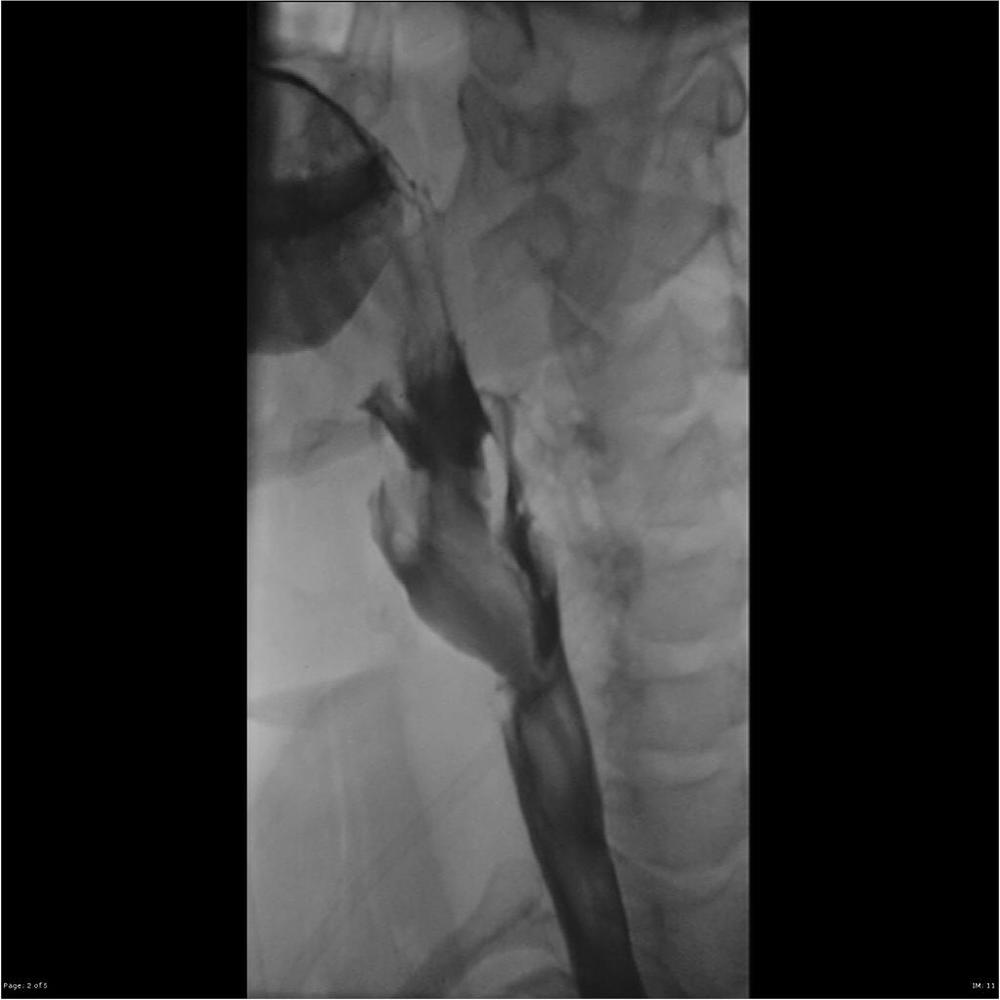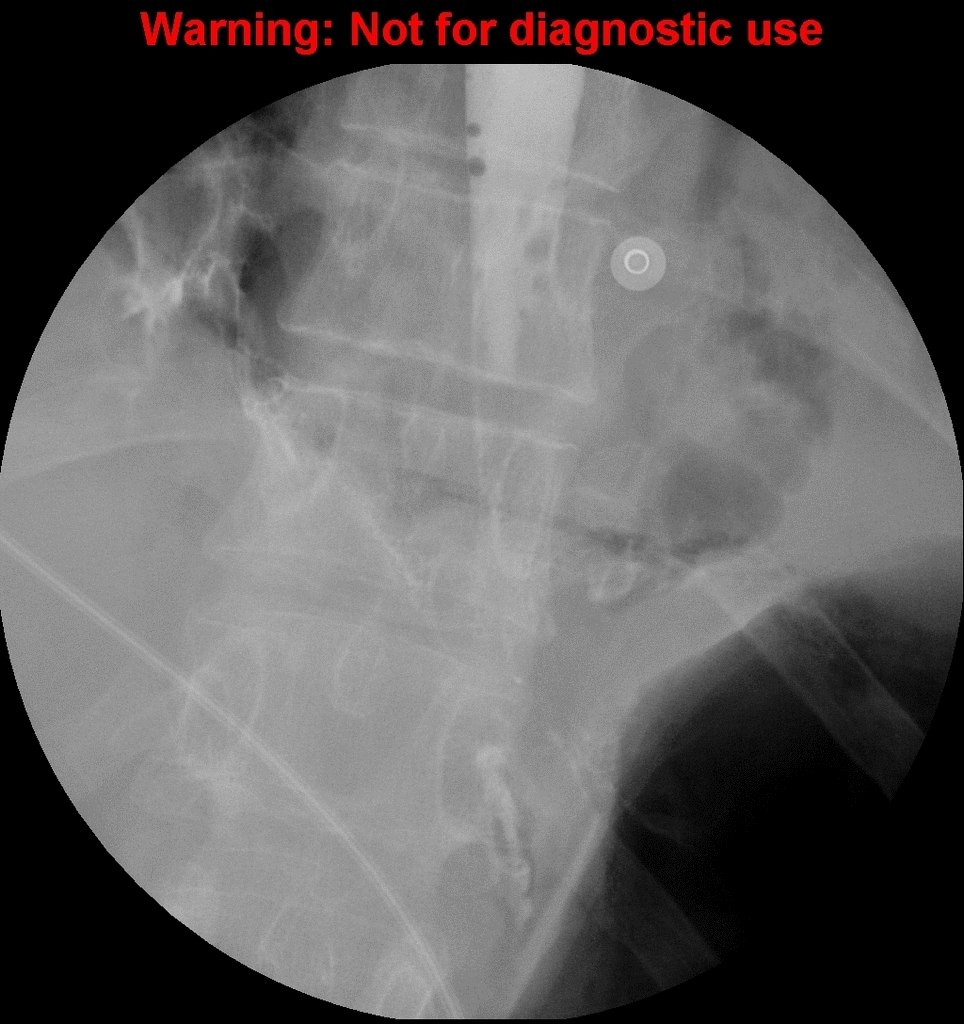Gastrointestinal perforation other imaging findings: Difference between revisions
(Created page with "__NOTOC__ {{CMG}}; {{AE}} {{MAD}} {{Gastrointestinal perforation}} ==Overview== Fluoroscopy most sensitive within the first 24 hours 1 patient examined semi-supine on fluor...") |
No edit summary |
||
| (5 intermediate revisions by the same user not shown) | |||
| Line 1: | Line 1: | ||
__NOTOC__ | __NOTOC__ | ||
{{CMG}}; {{AE}} {{MAD}} | {{CMG}}; {{AE}} {{MAD}} | ||
{{Gastrointestinal perforation}} | {{Gastrointestinal perforation}} | ||
==Overview== | ==Overview== | ||
Esophageal fluoroscopy is most sensitive within the first 24 hours. [[Small intestine|Small bowel]] follow through is inferior to [[Computed tomography|CT]] of the abdomen and pelvis with oral contrast for detection and localization of [[Intestinal perforation|small bowel perforation]]. | |||
most sensitive within the first 24 hours | |||
== Gastrointestinal perforation other imaging finding == | |||
=== Fluoroscopy === | |||
* [[Fluoroscopy|Esophageal fluoroscopy]] is most sensitive within the first 24 hours.<ref name="pmid7034570">{{cite journal| author=Meyer GW, Castell DO| title=Evaluation and management of diseases of the esophagus. | journal=Am J Otolaryngol | year= 1981 | volume= 2 | issue= 4 | pages= 336-44 | pmid=7034570 | doi= | pmc= | url=https://www.ncbi.nlm.nih.gov/entrez/eutils/elink.fcgi?dbfrom=pubmed&tool=sumsearch.org/cite&retmode=ref&cmd=prlinks&id=7034570 }}</ref> | |||
* A [[Water-soluble|water-soluble agent]] should be used initially as [[barium]] can cause [[mediastinitis]] and can produce [[granulomas]]. | |||
* [[Esophageal perforation]] may be represented as [[Mucous membrane|mucosal]] irregularity or gross extraluminal contrast extravasation. | |||
* [[Dye]] studies may be useful for evaluating patients with a [[pleural effusion]] and a [[Thoracotomy|thoracotomy tube]] who are suspected to have an esophageal leak.<ref name="pmid769536">{{cite journal| author=Lee SB, Kuhn JP| title=Esophageal perforation in the neonate. A review of the literature. | journal=Am J Dis Child | year= 1976 | volume= 130 | issue= 3 | pages= 325-9 | pmid=769536 | doi= | pmc= | url=https://www.ncbi.nlm.nih.gov/entrez/eutils/elink.fcgi?dbfrom=pubmed&tool=sumsearch.org/cite&retmode=ref&cmd=prlinks&id=769536 }}</ref> | |||
suspected | ==== Suspected gastroduodenal perforation ==== | ||
* An [[Upper gastrointestinal series|upper GI study]] with water-soluble [[contrast medium]] is not usually the primary study for detection of a suspected [[Stomach|gastric]] or [[Peptic ulcer|duodenal perforation]] but can be useful for confirmation of an equivocal appearance on [[Computed tomography|CT]] or for detection of the precise location of a small perforation.<ref name="pmid6758031">{{cite journal| author=Thompson WM, Kelvin FM, Gedgaudas RK, Rice RP| title=Radiologic investigation of peptic ulcer disease. | journal=Radiol Clin North Am | year= 1982 | volume= 20 | issue= 4 | pages= 701-20 | pmid=6758031 | doi= | pmc= | url=https://www.ncbi.nlm.nih.gov/entrez/eutils/elink.fcgi?dbfrom=pubmed&tool=sumsearch.org/cite&retmode=ref&cmd=prlinks&id=6758031 }}</ref> | |||
==== Suspected small bowel perforation ==== | |||
* [[Small intestine|Small bowel]] follow through is inferior to [[Computed tomography|CT]] of the [[abdomen]] and [[pelvis]] with oral contrast for detection and localization of [[Intestinal perforation|small bowel perforation]].<ref name="pmid18688562">{{cite journal| author=Di Saverio S, Catena F, Ansaloni L, Gavioli M, Valentino M, Pinna AD| title=Water-soluble contrast medium (gastrografin) value in adhesive small intestine obstruction (ASIO): a prospective, randomized, controlled, clinical trial. | journal=World J Surg | year= 2008 | volume= 32 | issue= 10 | pages= 2293-304 | pmid=18688562 | doi=10.1007/s00268-008-9694-6 | pmc= | url=https://www.ncbi.nlm.nih.gov/entrez/eutils/elink.fcgi?dbfrom=pubmed&tool=sumsearch.org/cite&retmode=ref&cmd=prlinks&id=18688562 }}</ref> | |||
[[File:Esophageal fluroscopy.gif|300px|center|thumb|Chest fluroscopy shows esophageal perforation, source: Case courtesy of RMH Core Conditions, Radiopaedia.org, rID: 26313]] | |||
[[File:Esophagel perforation fluroscopy.gif|300px|center|thumb|Chest fluroscopy shows esophageal perforation, source: Case courtesy of Dr Matt A. Morgan, Radiopaedia.org, rID: 45380]] | |||
==References== | ==References== | ||
{{Reflist|2}} | |||
Latest revision as of 03:47, 28 January 2018
Editor-In-Chief: C. Michael Gibson, M.S., M.D. [1]; Associate Editor(s)-in-Chief: Mohammed Abdelwahed M.D[2]
|
Gastrointestinal perforation Microchapters |
|
Differentiating gastrointestinal perforation from other diseases |
|---|
|
Diagnosis |
|
Treatment |
|
Case Studies |
|
Gastrointestinal perforation other imaging findings On the Web |
|
American Roentgen Ray Society Images of Gastrointestinal perforation other imaging findings |
|
Gastrointestinal perforation other imaging findings in the news |
|
Blogs on Gastrointestinal perforation other imaging findings |
|
Risk calculators and risk factors for Gastrointestinal perforation other imaging findings |
Overview
Esophageal fluoroscopy is most sensitive within the first 24 hours. Small bowel follow through is inferior to CT of the abdomen and pelvis with oral contrast for detection and localization of small bowel perforation.
Gastrointestinal perforation other imaging finding
Fluoroscopy
- Esophageal fluoroscopy is most sensitive within the first 24 hours.[1]
- A water-soluble agent should be used initially as barium can cause mediastinitis and can produce granulomas.
- Esophageal perforation may be represented as mucosal irregularity or gross extraluminal contrast extravasation.
- Dye studies may be useful for evaluating patients with a pleural effusion and a thoracotomy tube who are suspected to have an esophageal leak.[2]
Suspected gastroduodenal perforation
- An upper GI study with water-soluble contrast medium is not usually the primary study for detection of a suspected gastric or duodenal perforation but can be useful for confirmation of an equivocal appearance on CT or for detection of the precise location of a small perforation.[3]
Suspected small bowel perforation
- Small bowel follow through is inferior to CT of the abdomen and pelvis with oral contrast for detection and localization of small bowel perforation.[4]


References
- ↑ Meyer GW, Castell DO (1981). "Evaluation and management of diseases of the esophagus". Am J Otolaryngol. 2 (4): 336–44. PMID 7034570.
- ↑ Lee SB, Kuhn JP (1976). "Esophageal perforation in the neonate. A review of the literature". Am J Dis Child. 130 (3): 325–9. PMID 769536.
- ↑ Thompson WM, Kelvin FM, Gedgaudas RK, Rice RP (1982). "Radiologic investigation of peptic ulcer disease". Radiol Clin North Am. 20 (4): 701–20. PMID 6758031.
- ↑ Di Saverio S, Catena F, Ansaloni L, Gavioli M, Valentino M, Pinna AD (2008). "Water-soluble contrast medium (gastrografin) value in adhesive small intestine obstruction (ASIO): a prospective, randomized, controlled, clinical trial". World J Surg. 32 (10): 2293–304. doi:10.1007/s00268-008-9694-6. PMID 18688562.